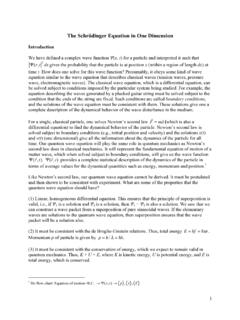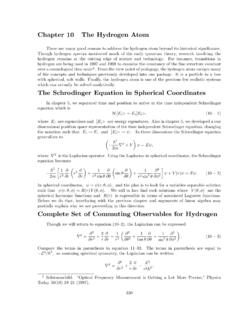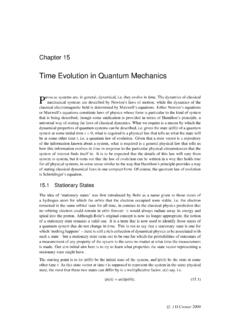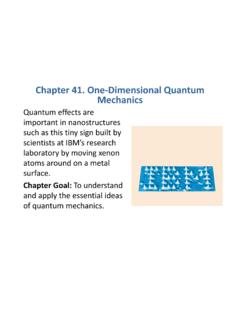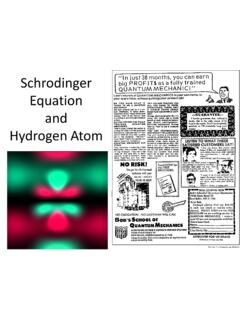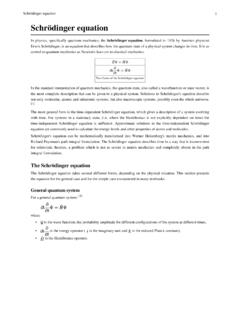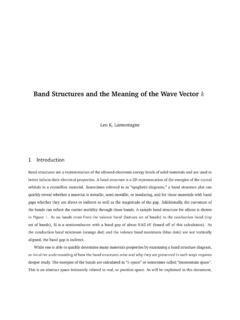Transcription of INTRODUCTION TO ELEMENTARY PARTICLES - msu.ru
1 INTRODUCTION TO ELEMENTARY PARTICLESWILEYD avid GriffithsReed CollegeJOHN WILEY & SONS, York Chichester Brisbane Toronto SingaporeINTRODUCTION TO ELEMENTARY PARTICLESC opyright 1987 John Wiley & Sons, rights reserved. Published simultaneously in or translation of any part of this work beyond that permit ted by Section 107 or 108 of the 1976 United States Copyright Act without the permission of the copyright owner is unlawful. Requests for permis sion or further information should be addressed to the Permissions De partment, John Wiley & Sons, of Congress Cataloging-in-Publication DataGriffiths, David J. (David Jeffrey), 1942- INTRODUCTION to ELEMENTARY bibliographies and PARTICLES (Nuclear physics) I. 1987 '21 86-25709 ISBN 0-471-60386-4 Printed and bound in the United States of America 20 19 18 17 16 15 14 CONTENTSP reface viiIntroduction 1 ELEMENTARY Particle Physics 1 How Do You Produce ELEMENTARY PARTICLES ?
2 4 How Do You Detect ELEMENTARY PARTICLES ? 7 Units 8 References and Notes 101 Historical INTRODUCTION to the ELEMENTARY PARTICLES The Classical Era (1897-1932) The Photon (1900-1924) Mesons (1934-1947) Antiparticles (1930-1956) Neutrinos (1930-1962) Strange PARTICLES (1947-1960) The Eightfold Way (1961-1964) The Quark Model (1964) The November Revolution and Its Aftermath (1974-1983) Intermediate Vector Bosons (1983) The Standard Model (1978-?) 46 References and Notes 49 Problems 512 ELEMENTARY Particle Dynamics The Four Forces Quantum Electrodynamics (QED) Quantum Chromodynamics (QCD) Weak Interactions Decays and Conservation Laws Unification Schemes 76 References and Notes 78 Problems 78iiiCONTENTSR elativistic Kinematics Lorentz Transformations Four-Vectors Energy and Momentum Collisions Examples and Applications 93 References and Notes 99 Problems 99 Symmetries , Groups.
3 And Conservation Laws and Orbital Angular of Angular Momenta \ Flavor Symmetries Conjugation Violation Reversal and the TCP Theorem References and Notes 135 Problems 137134 Bound States The schrodinger Equation for a Central Potential The Hydrogen Atom Fine Structure The Lamb Shift Hyperfine Structure Positronium Quarkonium Light Quark Mesons Baryons Baryon Masses and Magnetic Moments 180 References and Notes 184 Problems 186 The Feynman Calculus Lifetimes and Cross Sections The Golden Rule The Feynman Rules for a Toy Theory Lifetime of the A Scattering Higher-Order Diagrams 206 References and Notes 210 Problems 2117 Quantum Electrodynamics The Dirac Equation Solutions to the Dirac Equation Bilinear Covariants The Photon The Feynman Rules for Quantum Electrodynamics Examples Casimir s Trick and the Trace Theorems Cross Sections and Lifetimes Renormalization 246 References and Notes 250 Problems 2518 Electrodynamics of Quarks and Hadrons Electron-Quark Interactions Hadron Production in e+e~ Scattering Elastic Electron-Proton Scattering Inelastic Electron-Proton Scattering The Parton Model and Bjorken Scaling Quark Distribution Functions 273 References and Notes 277 Problems 2779 Quantum Chromodynamics Feynman Rules for Chromodynamics The Quark-Quark Interaction Pair Annihilation in QCD Asymptotic Freedom Applications of QCD 295 References and Notes 296 Problems 29610 Weak
4 Interactions Charged Leptonic Weak Interactions Decay of the Muon Decay of the Neutron Decay of the Pion Charged Weak Interactions of Quarks Neutral Weak Interactions Electroweak Unification 330 References and Notes 338 Problems 339 Gauge Lagrangian Formulation of Classical Particle Mechanics Lagrangians in Relativistic Field Theory Local Gauge Invariance Yang-Mills Theory Chromodynamics Feynman Rules The Mass Term Spontaneous Symmetry-Breaking The Higgs Mechanism 365 References and Notes 368 Problems 368 APPENDIX A. The Dirac Delta Function 372 APPENDIX B. Decay Rates and Cross Sections 376 APPENDIX C. Pauli and Dirac Matrices 378 APPENDIX D. Feynman Rules 380343 Index 384 PREFACEThis INTRODUCTION to the theory of ELEMENTARY PARTICLES is intended primarily for advanced undergraduates who are majoring in physics.
5 Most of my colleagues consider this subject inappropriate for such an audience mathematically too sophisticated, phenomelogically too cluttered, insecure in its foundations, and uncertain in its future. Ten years ago I would have agreed. But in the last decade the dust has settled to an astonishing degree, and it is fair to say that ELEMENTARY particle physics has come of age. Although we obviously have much more to learn, there now exists a coherent and unified theoretical structure that is simply too exciting and important to save for graduate School or to serve up in diluted qualitative form as a subunit of modem physics. I believe the time has come to integrate ELEMENTARY particle physics into the standard undergraduate , the research literature in this field is clearly inaccessible to undergraduates, and although there are now several excellent graduate texts, these call for a strong preparation in advanced quantum mechanics, if not quan tum field theory.
6 At the other extreme, there are many fine popular books and a number of outstanding Scientific American articles. But very little has been written specifically for the undergraduate. This book is an effort to fill that need. It grew out of a one-semester ELEMENTARY PARTICLES course I have taught from time to time at Reed College. The students typically had under their belts a semester of electromagnetism (at the level of Lorrain and Corson), a semester of quantum mechanics (at the level of Park), and a fairly strong background in special addition to its principal audience, I hope this book will be of use to beginning graduate students, either as a primary text, or as preparation for a more sophisticated treatment. With this in mind, and in the interest of greater completeness and flexibility, I have included more material here than one can comfortably cover in a single semester.
7 (In my own courses I ask the students to read Chapters 1 and 2 on their own, and begin the lectures with Chapter 3. I skip Chapter 5 altogether, concentrate on Chapters 6 and 7, discuss the first two sections of Chapter 8, and then jump to Chapter 10). To assist the reader (and the teacher) I begin each chapter with a brief indication of its purpose and content, its prerequisites, and its role in what book was written while I was on sabbatical at the Stanford Linear Accelerator Center, and I would like to thank Professor Sidney Drell and the other members of the Theory Group for their GriffithsIntroductionELEMENTARY PARTICLE PHYSICSE lementary particle physics addresses the question, What is matter made of? on the most fundamental level which is to say, on the smallest scale of size. It s a remarkable fact that matter at the subatomic level consists of tiny chunks, with vast empty spaces in between.
8 Even more remarkable, these tiny chunks come in a small number of different types (electrons, protons, neutrons, pi me sons, neutrinos, and so on), which are then replicated in astronomical quantities to make all the stuff around us. And these replicas are absolutely perfect copies not just pretty similar, like two Fords coming off the same assembly line, but utterly indistinguishable. You can t stamp an identification number on an electron, or paint a spot on it if you ve seen one, you ve seen them all. This quality of absolute identicalness has no analog in the macroscopic world. (In quantum mechanics it is reflected in the Pauli exclusion principle.) It enormously simplifies the task of ELEMENTARY particle physics: we don t have to worry about big electrons and little ones, or new electrons and old ones an electron is an electron is an electron.
9 It didn t have to be so first job, then, is to introduce you to the various kinds of ELEMENTARY PARTICLES , the actors, if you will, in the drama. I could simply list them, and tell you their properties (mass, electric charge, spin, etc.), but I think it is better in this case to adopt a historical perspective, and explain how each particle first came on the scene. This will serve to endow them with character and personality, making them easier to remember and more interesting to watch. Moreover, some of the stories are delightful in their own the PARTICLES have been introduced, in Chapter 1, the issue becomes, How do they interact with one another? This question, directly or indirectly, will occupy us for the rest of the book. If you were dealing with two macroscopic12 INTRODUCTION objects, and you wanted to know how they interact, you would probably begin by suspending them at various separation distances and measuring the force between them.
10 That s how Coulomb determined the law of electrical repulsion between two charged pith balls, and how Cavendish measured the gravitational attraction of two lead weights. But you can t pick up a proton with tweezers or tie an electron onto the end of a piece of string; they re just too small. For practical reasons, therefore, we have to resort to less direct means to probe the interactions of ELEMENTARY PARTICLES . As it turns out, almost all our experimental information comes from three sources: (1) scattering events, in which we fire one particle at another and record (for instance) the angle of deflection; (2) decays, in which a particle spontaneously disintegrates and we examine the debris; and (3) bound states, in which two or more PARTICLES stick together, and we study the properties of the composite object.
